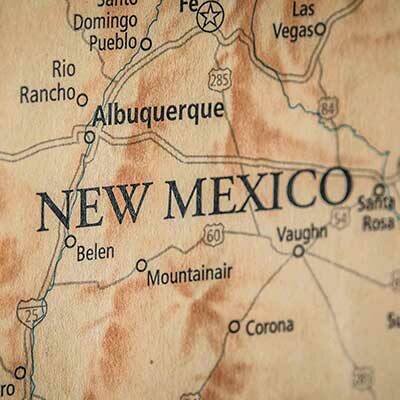New Mexicans await military response two years after Cannon revealed PFAS contamination
Laura Paskus
September 22, 2020
“I’m still dumping milk, my cows are still dying, and the Air Force hasn’t done nothing.”
It’s been more than two years since the U.S. Air Force notified state officials that toxic chemicals from their firefighting foams had seeped into the groundwater below Cannon Air Force Base—and into the well water of nearby homes and Art Schaap’s Clovis dairy.
“Right now, they’re still polluting the groundwater,” says Schaap, whose farm overlooks Cannon’s airfield. “It’s unbelievable. We can’t believe it. We cannot believe it.”
When Schaap learned the military had polluted his well water with PFAS, or per- and polyfluoroalkyl substances, he had to stop selling milk from his Clovis dairy.
Even though the Air Force stopped using the firefighting foams with high levels of PFAS, those toxic compounds persist in the environment. PFAS don’t biodegrade, but in fact, do the opposite: they bioaccumulate, moving on up the food chain. They’ve been linked to cancer and many other health problems.
Today, Schaap estimates he still spends somewhere between $7,600 and $11,400 a day feeding the 3,800 cows he can’t milk or sell because they drank contaminated water. He says his dairies in Portales keep his family afloat. But that’s not going to last much longer, and he worries that by the end of this year, he’ll file for bankruptcy.
“Right now, we’re just standing on our own,” says Schaap. “They’ve been polluting this water for 20 years, but we found out two years ago.”
In 2018, the Air Force notified New Mexico officials that tests at Cannon—and Holloman Air Force Base in Alamogordo—detected perfluorooctanesulfonic acid (PFOS) and perfluorooctanoic acid (PFOA) from firefighting foams that the military started using in the 1970s. PFOA and PFOS are just two of the thousands of compounds in the PFAS family.
Since then, New Mexico has tried to hold the Air Force responsible for the pollution. But despite cleanup orders, lawsuits, widespread acknowledgement of the dangers of PFAS, and progress at other contaminated bases across the nation, the military has yet to even map the pollution at Cannon and Holloman. And while the state and the Air Force recently settled over a disputed wastewater discharge permit at Cannon, that agreement doesn’t move cleanup forward, New Mexico Environment Department (NMED) Secretary James Kenney told NMPBS.
“We’re always appreciative when people want to settle,” Kenney says. “Because at the end of the day, it’s about compliance, not penalties.”
But the Air Force has yet to demonstrate a similar willingness to come to the table over cleanup, he says.
“When it comes to the delineation and remediation of the plume, if they wanted to settle with us, they could reach out. And that has not happened,” Kenney says. “That is a good indication that they are not respecting the community in which they do business, and the community in and around Clovis who rely on well water and public water supplies fed by the aquifer where PFAS has been detected.”
Although the U.S. Environmental Protection Agency set a lifetime health advisory for PFOS and PFOA, it has not set enforceable standards for them, or the roughly 7,000 other compounds in the PFAS family. Standards that would allow states like New Mexico to have more control over pollution from places like Cannon and Holloman.
That’s not because the toxins aren’t dangerous. Decades’ worth of studies tie PFAS to reproductive and developmental problems, liver and kidney disease, and immune system problems. Exposure is also linked to high cholesterol, low infant birth weights, thyroid hormone disruption, and cancer.
Under the EPA’s health advisory, you shouldn’t ingest more than 70 parts per trillion of PFOA and PFOS over the course of your entire life.
That’s a tiny number compared with what the military found in New Mexico’s waters.
In the waters below Cannon, PFAS levels were more than 370 times that lifetime limit. The toxins also made their way into about ten percent of the wells—now closed—that supply Clovis’s drinking water. And at Holloman, PFAS levels were more than 27,000 times the lifetime limit.
After learning about the groundwater contamination at Cannon and Holloman, New Mexico issued notices of violation against the Air Force in 2018. According to the state, the military had violated the state’s Water Quality Act—and at Cannon, the notice required the Air Force come up with a plan to protect dairies and evaluate the possibility of installing filtration or treatment systems.
Instead, the Air Force sued New Mexico, challenging the state’s authority.
Then, in March 2019, New Mexico filed a separate lawsuit, asking a federal District Court judge to order the military to act on and fund cleanup at Cannon and Holloman.
“The idea was to get immediate relief to the people whose groundwater had been affected,” says Cholla Khoury, director of consumer and environmental protection at the New Mexico Office of the Attorney General.
That suit was meant as something of an emergency action—to get the Air Force moving on cleanup, and quickly.
“We know there is significant contamination in the groundwater at those two locations and we’re claiming substantial and imminent endangerment under [the federal Resource Conservation and Recovery Act] and New Mexico state laws,” Khoury says.
Since 2019, she explains, the case has been moved to multi-district litigation and a court in South Carolina which is overseeing all cases regarding PFAS and the military’s use of the polluting firefighting foams. Currently, that includes 750 separate cases.
NMED’s Kenney says the state tried to extricate itself from the multidistrict litigation and pursue its case against the Air Force without being slowed down and tied to hundreds of other cases.
But United States District Judge Mark Gergel agreed with the Air Force, the U.S. government, the Defense Coordination Committee, and the Plaintiffs’ Executive Committee and denied that request. According to Gergel’s order, “resolution of the issues raised [by New Mexico] is premature and it could prejudice other cases involving the same issues.”
Kenney says that among the plaintiffs who opposed New Mexico’s request were attorneys for Art Schaap, who sued the U.S. Department of the Defense and the Air Force for failing to notify dairies of the contamination and failing to supply replacement water. He also sued the manufacturers of the toxic chemicals, and like the state’s lawsuit against the military, the suit was moved to the South Carolina district court.
“Our ability to hold DOD accountable more quickly was effectively blocked by Mr. Schaap’s counsel,” Kenney says. “And we don’t know why that is.
NMPBS left messages with attorneys with both the firms representing Schaap, Napoli Shkolnik PLLC and Portales-based Doerr & Knusdon. We’ll update our coverage with that information once we hear back from them.
Meanwhile, local officials have no idea when the pollution will be tackled.
“A lot of us have this feeling, well, we just feel like we’re like the little bitty guy facing the big giant of the Air Force,” says Robert Sandoval, a Curry County commissioner. “I've been frustrated for a long time now, and I don’t see the light at the end of the tunnel. I know it’s there. But it’s too far away for me to see it.”
A self-described optimist, Sandoval does believe the Air Force has finally decided it has a responsibility to fix the problem.
“But it seems like government works very, very slowly,” he says. “And I have no idea what they’re going to do or when they’re going to start doing it.”
When the New Mexico Water Quality Control Commission met this month to vote on the settlement agreement between the Air Force and the state of New Mexico John Kern with the group Clean Water Partnership opposed that agreement.
Kern believes the settlement allows Cannon to continue releasing wastewater onto leach fields and a lagoon, into arroyos, and onto the base’s golf course—and continue polluting.
To be clear, the agreement doesn’t affect the dueling lawsuits. Rather, it centers around a wastewater discharge permit. In early 2020, the New Mexico Environment Department dinged the Air Force for not monitoring the groundwater at Cannon for PFAS contamination—which the state said was required under the military’s wastewater discharge permit. In its January 2020 order, the state demanded compliance with state law and fined the military nearly $1.7 million.
In a settlement dated in early July, the two parties came to an agreement: Cannon would submit a new permit application and pay an administrative fee of $250,947.60. And at its September meeting, the state’s Water Quality Control Commission voted unanimously to accept the settlement.
Kern says that two years ago the commission added three PFAS chemicals, including PFOA and PFOS, to the state’s list of toxic pollutants. “They passed a regulation about PFAS in 2018 but have now exempted [Cannon] to continue operating according to a 2014 permit?” he says. “All is forgiven, for a quarter of a million dollars?”
Kern’s group is also frustrated at how base officials have battened down against any communication with the community. “CWP tried to schedule a town hall with the base commander this summer, but he refused, citing the ongoing litigation,” Kern says.
Cannon has yet to even map out where the contamination has spread. Instead, New Mexico is spending a million dollars to fund that work, which is expected to begin in 2021.
Nationwide, the military is investigating PFAS contamination at more than 700 bases and installations—34 more were added to the list this month, including New Mexico’s Fort Wingate. And those site studies and cleanup efforts are all in various stages. In Texas, for example, Kern points out that near the now-closed Reese Air Force Base, the military has tested hundreds of wells and provided hundreds of homes with filtration systems.
Kenney agrees that cleanup at New Mexico’s bases lags those in other states.
He speculates that the military considers various factors when prioritizing cleanup, including whether the PFAS levels in drinking water exceed the lifetime health advisory, whether state and federal officials are pursuing a remedy, and if NGOs and the community are urging action. And, he added: “I hope the DOD is not treating states differently for political purposes.”
The public information officer for Cannon Air Force Base did not respond to emailed questions from NMPBS or a request for an interview with Coon.
Meanwhile, Art Schaap is still waiting for the military to supply clean water to his dairy. As a dairy farmer, Schaap says, he follows state and federal laws. If he broke those laws, regulators would shut him down. The same is true for any other industry in the state, he says.
“But for some reason, [state regulators] gave a pass to Cannon,” he says, referring to the settlement. “My community has done nothing, the City of Clovis has done nothing, the county has done nothing. Everybody’s like a deer in the headlights with Cannon Air Force Base.”
The settlement, he says doesn’t stop the pollution or protect people like him from the Air Force’s continued contamination of the groundwater around Clovis. He’s also disappointed that city and county officials don't stand up to the Air Force.
“There’s been communities in other states that had PFAS, and they pushed back, and the Air Force there started cleaning up the water,” says Schaap. “When I read about that, I thought, ‘If our community would put pressure on Cannon, would they do that?”
If you’ve been affected by PFAS contamination in your community, call our tip line at (505) 433-7242. To read more coverage of PFAS in New Mexico visit “Groundwater War: New Mexico’s Toxic Threat,” which includes a timeline of events and studies on PFAS.







[…] […]
[…] That lawsuit is still pending. So is the lawsuit the military filed against New Mexico, challenging the state’s authority. […]
[…] use of aqueous film forming foam—more than 750 separate cases. To speed up action, the state requested to pull itself out from that multi-district litigation. But in September, the judge denied that […]
[…] waters below Cannon Air Force Base. More than two years later, dairy farmers like Art Schaap are still waiting for relief, the drinking water utility in Clovis has shut down drinking water wells, and the military and the […]
[…] use of aqueous film forming foam—more than 750 separate cases. To speed up action, the state requested to pull itself out from that multi-district litigation. But in September, the judge denied that […]
[…] New Mexico has already tried to extricate itself from the multidistrict litigation, hoping to pursue its case against the Air Force without being tied those hundreds of other cases. […]
[…] When the state of New Mexico tried to compel the military to clean the pollution under state hazardous waste rules, the military sued, saying the state lacked the authority to require action. (New Mexico filed a second lawsuit, asking a federal judge to compel cleanup, but that lawsuit has gotten mired in multi-district litigation in a South Carolina court.) […]